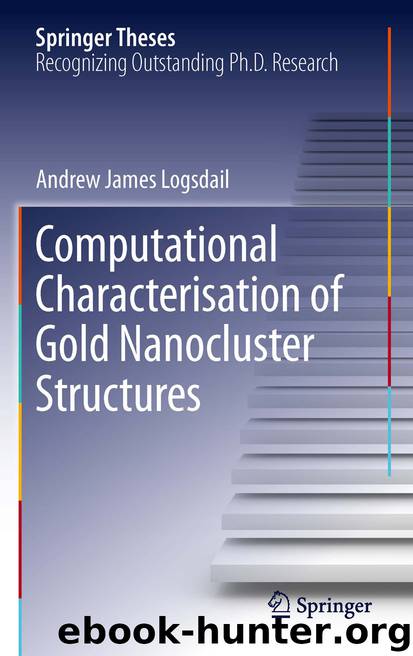Computational Characterisation of Gold Nanocluster Structures by Andrew James Logsdail

Author:Andrew James Logsdail
Language: eng
Format: epub
Publisher: Springer International Publishing, Cham
Results of adsorption on an HOPG substrate with and without surface vacancies, with C atoms unconstrained within 7.0 Å of the cluster, are given in Appendix C.5. General trends are as previously observed for adsorption on to a surface with an unconstrained distance of 3.5 Å (Table 4.1). The increased freedom of the C atoms results in minimal changes to the range of , and thus the hierarchy of the different cluster-substrate interactions. The only relational difference is the decrease in for (111) face adsorption on GR2-2h when compared to GR2-h, which is noted as being due to distortion of the starting -symmetry geometry. (X) increases throughout due to the greater area of C free movement, directly leading to decreased (Au) values as the vertical displacement of the top HOPG layers increases. Though an Au atom still sits in plane for calculations on GR2-2h and GR2-3h, there is an increased bending in the topmost HOPG layer; and thus greater displacement. The increased planar bending also effects , with values more negative across the board (GR2, GR2-h, GR2-2h and GR2-3h). Calculated interlayer distances and (X) for the isolated HOPG systems with both 3.5 and 7.0 Å of unconstrained C atoms are given in Appendix C.5, reaffirming the observation that the surface bending is predominantly a cluster-induced effect.Table 4.2Structural analysis of cluster on HOPG graphite with and without multiple surface defects as defined for 4.1
Download
This site does not store any files on its server. We only index and link to content provided by other sites. Please contact the content providers to delete copyright contents if any and email us, we'll remove relevant links or contents immediately.
The Mikado Method by Ola Ellnestam Daniel Brolund(20603)
Hello! Python by Anthony Briggs(19899)
Secrets of the JavaScript Ninja by John Resig Bear Bibeault(18208)
Dependency Injection in .NET by Mark Seemann(18108)
The Well-Grounded Java Developer by Benjamin J. Evans Martijn Verburg(17575)
OCA Java SE 8 Programmer I Certification Guide by Mala Gupta(17421)
Kotlin in Action by Dmitry Jemerov(17185)
Adobe Camera Raw For Digital Photographers Only by Rob Sheppard(16930)
Algorithms of the Intelligent Web by Haralambos Marmanis;Dmitry Babenko(16235)
Grails in Action by Glen Smith Peter Ledbrook(15390)
Test-Driven iOS Development with Swift 4 by Dominik Hauser(10393)
Becoming a Dynamics 365 Finance and Supply Chain Solution Architect by Brent Dawson(8055)
Microservices with Go by Alexander Shuiskov(7819)
Practical Design Patterns for Java Developers by Miroslav Wengner(7719)
Test Automation Engineering Handbook by Manikandan Sambamurthy(7671)
Angular Projects - Third Edition by Aristeidis Bampakos(7159)
The Art of Crafting User Stories by The Art of Crafting User Stories(6611)
NetSuite for Consultants - Second Edition by Peter Ries(6533)
Demystifying Cryptography with OpenSSL 3.0 by Alexei Khlebnikov(6305)
